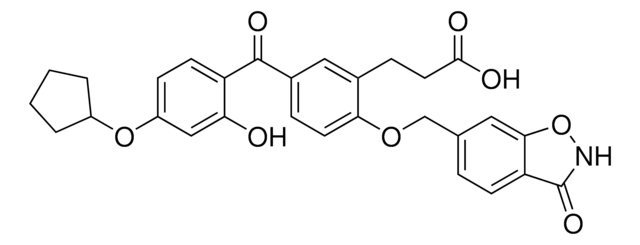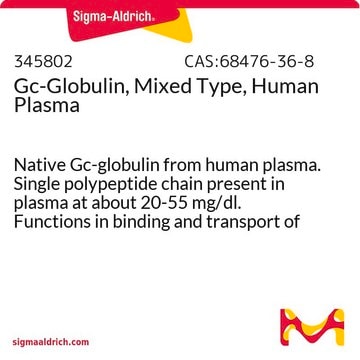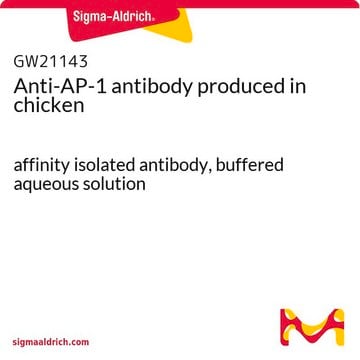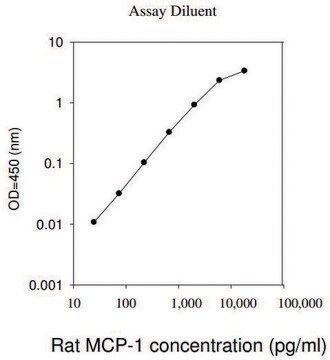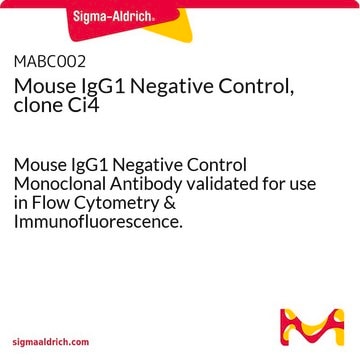17-604
ChIPAb+ LEF1 - ChIP Validated Antibody and Primer Set
from mouse
Se connecterpour consulter vos tarifs contractuels et ceux de votre entreprise/organisme
About This Item
Code UNSPSC :
12352203
eCl@ss :
32160702
Nomenclature NACRES :
NA.52
Produits recommandés
Source biologique
mouse
Niveau de qualité
Clone
monoclonal
Espèces réactives
human, mouse
Fabricant/nom de marque
ChIPAb+
Upstate®
Technique(s)
ChIP: suitable
western blot: suitable
Isotype
IgG1
Numéro d'accès NCBI
Numéro d'accès UniProt
Conditions d'expédition
dry ice
Informations sur le gène
human ... LEF1(51176)
Description générale
Every lot of the ChIPAb+ line of antibodies is individually validated for chromatin precipitation, in order to guarantee successful ChIP assays every time. Each antibody includes a control primer set for performance confirmation. LEF1 antibody and the negative control antibody (mouse normal IgG) can be used to demonstrate that the LEF1 antibody is functionally validated in the precipitation of LEF1 associated chromatin.
The qPCR primers included flank the LEF1/TCF binding site in human c-myc promoter.
The qPCR primers included flank the LEF1/TCF binding site in human c-myc promoter.
Spécificité
Recognizes LEF1 (lymphoid enhancer-binding factor 1).
Immunogène
The antibody is made against amino acid residues 1-85 of human LEF1.
Application
Research Category
Epigenetics & Nuclear Function
Epigenetics & Nuclear Function
Research Sub Category
Chromatin Biology
Transcription Factors
Chromatin Biology
Transcription Factors
Use ChIPAb+ LEF1 Mouse Monoclonal Antibody validated in WB, ChIP for the detection of LEF1.
Western Blot Analysis:
Jurkat cell lysate was resolved by electrophoresis, transferred to nitrocellulose and probed with anti-LEF1 (1 mg/mL). Proteins were visualized using a goat antimouse secondary antibody conjugated to HRP and a chemiluminescence detection system (Please see figures).
Jurkat cell lysate was resolved by electrophoresis, transferred to nitrocellulose and probed with anti-LEF1 (1 mg/mL). Proteins were visualized using a goat antimouse secondary antibody conjugated to HRP and a chemiluminescence detection system (Please see figures).
Conditionnement
25 assays per kit. ~4μg per chromatin immunoprecipitation.
Qualité
Chromatin Immunoprecipitation:
Sonicated chromatin prepared from 3x106 HT29 cells was subjected to chromatin immunoprecipitation using 4 μg of either the negative control antibody, Mouse Normal IgG or mouse Anti-LEF1 and the Magna ChIP® G kit (Cat.# 17-611).
Successful enrichment of LEF1 associated DNA fragments was verified by qPCR using ChIP Primers c-myc flanking the human c-myc promoter that contains LEF1 binding sites (Please see figures).
Please refer to the EZ-Magna ChIP G (Cat.# 17-409) or EZ-ChIP (Cat.# 17-371) kit protocols for experimental details.
Sonicated chromatin prepared from 3x106 HT29 cells was subjected to chromatin immunoprecipitation using 4 μg of either the negative control antibody, Mouse Normal IgG or mouse Anti-LEF1 and the Magna ChIP® G kit (Cat.# 17-611).
Successful enrichment of LEF1 associated DNA fragments was verified by qPCR using ChIP Primers c-myc flanking the human c-myc promoter that contains LEF1 binding sites (Please see figures).
Please refer to the EZ-Magna ChIP G (Cat.# 17-409) or EZ-ChIP (Cat.# 17-371) kit protocols for experimental details.
Description de la cible
55-57 kDa
Forme physique
Anti-LEF1 (mouse IgG1). 1 vial containing 100 mg of thiophilic and size exclusion chromatography purified mouse IgG1 in 100 mL of phosphate buffered saline with sodium azide. Store at-20°C. The antibody is made against amino acid residues 1-85 of human LEF1 and can recognize human and mouse LEF1. It does not cross-react with TCF-3 or TCF-4.
Normal Mouse IgG. One vial containing 125 μg of normal mouse IgG in 125 μL volume. Store at -20°C.
ChIP primers c-myc. One vial containing 75 mL of 5 μM of each control primer specific for human c-myc promoter. Store at -20°C.
FOR: CCC AAA AAA AGG CAC GGA A
REV: TAT TGG AAA TGC GGT CAT GC
Normal Mouse IgG. One vial containing 125 μg of normal mouse IgG in 125 μL volume. Store at -20°C.
ChIP primers c-myc. One vial containing 75 mL of 5 μM of each control primer specific for human c-myc promoter. Store at -20°C.
FOR: CCC AAA AAA AGG CAC GGA A
REV: TAT TGG AAA TGC GGT CAT GC
Format: Purified
Stockage et stabilité
1 year at -20°C from date of shipment
Remarque sur l'analyse
Control
Includes negative control mouse IgG antibody and control primers specific for human c-myc promoter.
Includes negative control mouse IgG antibody and control primers specific for human c-myc promoter.
Informations légales
MAGNA CHIP is a registered trademark of Merck KGaA, Darmstadt, Germany
UPSTATE is a registered trademark of Merck KGaA, Darmstadt, Germany
Clause de non-responsabilité
Unless otherwise stated in our catalog or other company documentation accompanying the product(s), our products are intended for research use only and are not to be used for any other purpose, which includes but is not limited to, unauthorized commercial uses, in vitro diagnostic uses, ex vivo or in vivo therapeutic uses or any type of consumption or application to humans or animals.
Code de la classe de stockage
10 - Combustible liquids
Certificats d'analyse (COA)
Recherchez un Certificats d'analyse (COA) en saisissant le numéro de lot du produit. Les numéros de lot figurent sur l'étiquette du produit après les mots "Lot" ou "Batch".
Déjà en possession de ce produit ?
Retrouvez la documentation relative aux produits que vous avez récemment achetés dans la Bibliothèque de documents.
A-D Zhou et al.
Oncogene, 31(24), 2968-2978 (2011-10-25)
The microRNA-371-373 (miR-371-373) cluster is specifically expressed in human embryonic stem cells (ESCs) and is thought to be involved in stem cell maintenance. Recently, microRNAs (miRNAs) of this cluster were shown to be frequently upregulated in several human tumors. However
Ana Paula Azambuja et al.
PLoS genetics, 17(1), e1009296-e1009296 (2021-01-20)
The process of cell fate commitment involves sequential changes in the gene expression profiles of embryonic progenitors. This is exemplified in the development of the neural crest, a migratory stem cell population derived from the ectoderm of vertebrate embryos. During
Debadrita Bhattacharya et al.
eLife, 7 (2018-12-07)
A crucial step in cell differentiation is the silencing of developmental programs underlying multipotency. While much is known about how lineage-specific genes are activated to generate distinct cell types, the mechanisms driving suppression of stemness are far less understood. To
Jun Won Park et al.
Stem cells (Dayton, Ohio), 34(5), 1177-1187 (2016-02-13)
There is a strong need to identify markers to enrich gastric cancer stem cells (CSCs). However, CSC enrichment markers for mouse gastric cancers have not yet been determined. In our previous study, we generated primary mouse gastric cancer cell line
Xueping Wang et al.
PloS one, 10(11), e0143142-e0143142 (2015-11-19)
TYR, DCT and MITF are three important genes involved in maintaining the mature phenotype and producing melanin; they therefore participate in neural crest cell development into melanocytes. Previous studies have revealed that the Wnt signaling factor lymphoid enhancer-binding factor (LEF-1)
Notre équipe de scientifiques dispose d'une expérience dans tous les secteurs de la recherche, notamment en sciences de la vie, science des matériaux, synthèse chimique, chromatographie, analyse et dans de nombreux autres domaines..
Contacter notre Service technique


